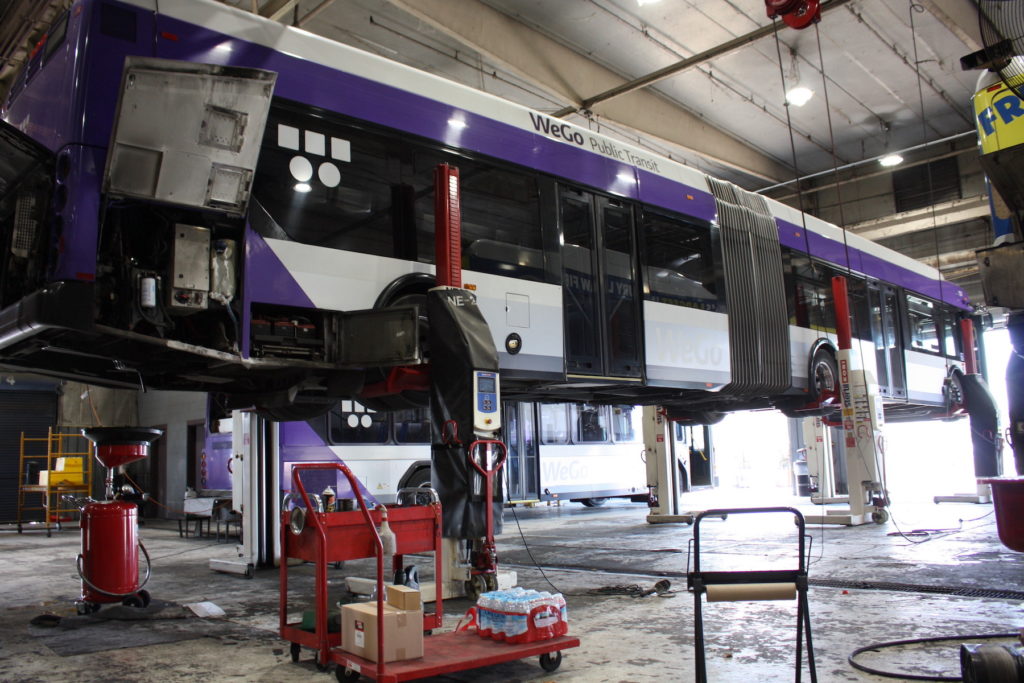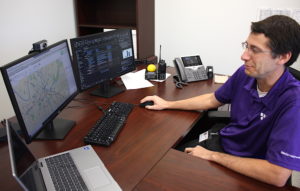
Nashville’s WeGo bus system rolled out adjustments to its routes and schedules this week for about two dozen bus lines. But riders don’t necessarily see what’s happening behind the scenes, as WeGo leaders increasingly tap into huge amounts of data to inform decisions.
To learn more — and as part of reporting for a recent episode of This Is Nashville — WPLN’s Tony Gonzalez caught up with Dan Freudberg, WeGo’s deputy chief operating officer.
Watching in real-time
These days, WeGo can monitor its fleet — which is roughly 200 vehicles — in real-time. On his row of computer monitors, Freudberg can zoom in and out on a map that shows a bus logo representing each one inching along a roadway. They are color coded to show whether each bus is running on-time, early or late.
 Tony Gonzalez WPLN News
Tony Gonzalez WPLN NewsDan Freudberg, with WeGo, demonstrates the agency’s real-time monitoring system.
In just a few clicks, he can check on what’s typical for that route — or even for a particular driver — and supervisors can also open up immediate radio communications with a driver if adjustments are needed.
“We don’t want to be ahead of schedule; somebody could miss their vehicle,” Freudberg says. “But just a couple of minutes late, they’re more or less arriving when people are expecting it.”
The quest to stay on schedule
As important as the map view is what’s known as the “route ladder,” which shows every bus on a single route, and whether they are properly spaced out. Compared to the map, it’s even easier to see quickly whether problems are developing that will push the buses off schedule.
During the tour, Freudberg showed how Gallatin Road had 12 buses coming and going from downtown.
The pitfall is when “bus bunching” occurs. That’s when one bus falls behind, and the next bus is running ahead. It doesn’t help bus riders if two buses arrive in rapid succession. That erodes trust in the system and can lead to some buses being nearly empty and others overcrowded.
please ask Trey what we are doing to prevent bus bunching. it’s extremely bad on Murfreesboro Pike. sometimes there will be periods of 30 minutes where no bus comes and then 3 busses come with 10 minutes.
— jeremiah (@woo_ten) October 5, 2022
If supervisors act quickly enough, they can ask drivers to wait an extra minute or two at a stop, “something that’s not too disruptive to the passengers.”
WeGo can also deploy extra buses, which are stationed throughout the county.
The agency is also exploring whether it can do more with a technology that allows buses to message with traffic signals, “where the bus can actually send a request to … hold the green light for an extra few seconds to allow the bus to get through.”
Era of big data
Freudberg has been with WeGo for 12 years and says a lot of the data is newly available over that time.
The bus fleet now generates about 500,000 data points each month.
So in addition to the real-time monitoring, WeGo works to analyze the trends when adjusting schedules twice each year.
“They can look at things like not just what it takes on a typical day, but also how long does it take on some of the worst days?” Freudberg says.
One crucial metric: How many buses begin their runs on time? As any commuter or driver knows, a late start can throw off the timing of an entire trip. WeGo wants to pinpoint issues, like if drivers aren’t being given enough transition time.
Parking lot precision
As reliable as GPS is for most people, it has some blind spots — including when it comes to managing a bus fleet.
“If they’re parked close together or they’re in an underground facility … GPS doesn’t work very well,” Freudberg says.
For WeGo, both of those scenarios occur many times each day. It actually means that staffers have to walk around a couple times each day to map where each vehicle is parked.
 Tony Gonzalez
Tony Gonzalez WeGo is working on a better system for tracking the maintenance needs of city buses.
This is why the agency is installing another technology to help pinpoint exactly where the buses are, down to the exact parking spot or garage bay. The database will also track the maintenance status of each bus. This way, each can get work like oil changes completed on time.
These granular details can make the system more dependable.
“At the end of the day, you’re just trying to get people from point A to point B when they want to get there,” says Freudberg.

